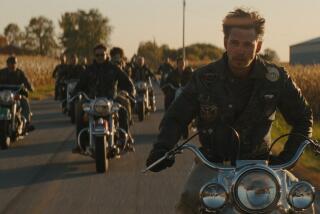The fade-out of L.A.’s punk rock scene
Set in the waning days of the Los Angeles punk scene, “Border Radio” is the first feature by Allison Anders, who co-wrote and co-directed it with Kurt Voss and Dean Lent. This relatively unheralded 1987 indie -- a DIY effort from three UCLA film students -- may seem an odd fit for the Criterion Collection, which has been doing a superb job of issuing definitive DVD editions for acknowledged world cinema classics.
In its way, though, this charmingly scruffy movie, which came out Tuesday, is a valuable time capsule and as much a milestone in the history of American independent film as “sex, lies and videotape” or “Clerks.” It lacks the stature of those Sundance hits, but this semi-improvised pseudo road movie, an even more laid-back West Coast cousin of Jim Jarmusch’s “Stranger Than Paradise,” is precisely the stuff that underdog myths are made of.
With borrowed equipment, a few thousand dollars and more determination than know-how, Anders, Voss and Lent started working on “Border Radio” in 1983. They finished it four years later. The drawn-out shoot resulted in some continuity problems: for one, Anders’ daughter Devon, who played the offspring of the two main characters, aged from 5 to 9.
The movie bears obvious film-school flourishes. The arch intertitles and unexplained interviews that pop up throughout seem like the direct consequence of a youthful Godard binge. On the commentary track, Voss and Anders, who later co-directed another L.A. music-biz drama, “Sugar Town” (1999), stress the importance of the German New Wave in their formative years, name-dropping Werner Herzog and Wim Wenders.
The filmmakers had intended to make a neo-noir. The singer-songwriter protagonist, Jeff Bailey, is named for Robert Mitchum’s luckless hero in Jacques Tourneur’s 1947 classic “Out of the Past” and there are narrative similarities too (stolen cash, an escape to Mexico). But once they cast Chris D., the frontman of local band the Flesh Eaters, in the lead, “Border Radio” evolved into a portrait of a scene.
Or more to the point, the disintegration of a scene. This good-natured yet lightly mournful movie is something of an elegy. Many of the locations are clubs and hangouts that even then were on the brink of closure; the cast is densely populated with denizens of the punk and post-punk community who (on- and off-screen) were feeling their way through awkward transitions.
His career in stasis, Jeff robs a nightclub and heads south of the border, holing up in a trailer by the beach for some soul-searching (the film’s brooding score is by another punk scenester, Dave Alvin of the Blasters). In a real-life parallel, Chris D. had disbanded the Flesh Eaters in 1983; he went on to record under the name Divine Horseman.
The plot loosely revolves around the efforts of Jeff’s rock-critic wife, Luanna (Luanna Anders, sister of Allison, in a wonderfully brisk performance), to extricate him from the mess he’s in.
She does so with the questionable help of Jeff’s goofball roadie (Chris Shearer), with whom she’s occasionally sleeping, and his erstwhile bandmate Dean (John Doe, the charismatic leader of punk legends X).
Jeff and Luanna’s tense relationship provides “Border Radio” with its main drama, even though -- like repellent magnetic fields -- they never once appear in the same scene. Allison Anders and Voss were a couple at the time, and Voss acknowledges that the movie ended up depicting “an awful lot of our sexual politics and conflicts.”
The real star of “Border Radio” is Lent’s black-and-white, 16-millimeter cinematography, which dates the movie as much as the posters and fliers taped to the walls of the characters’ apartments (today a shoestring labor of love like this would invariably be shot on digital video). His beautifully lighted and composed images go a long way toward offsetting the amateur-hour acting and shaggy-dog plotting.
The film cleans up nicely enough in Criterion’s high-definition transfer, and there’s the usual bonanza of extras, including a brief making-of doc and uncommonly gregarious commentary tracks by the filmmakers and actors.
More to Read
Only good movies
Get the Indie Focus newsletter, Mark Olsen's weekly guide to the world of cinema.
You may occasionally receive promotional content from the Los Angeles Times.










